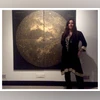The 20 exhibits are a combination of traditional and contemporary techniques, textile art, painting and video
)
Ojasvi Gupta New Delhi
Argentine-Mexican visual artist Irene Dubrovsky has always wanted to visit India. Her works, which offer a journey through celestial cartography, are in a lot of ways intertwined with India’s religious, mythological, and scientific traditions that have a deep connection with the stars and their positioning.
Dubrovsky’s inaugural exhibition in New Delhi, titled, “La escritura de lo infinito”, Spanish for “The Script of the Infinite”, is a culmination of that desire.
Click here to connect with us on WhatsApp
The exhibition is being hosted by the Embassy of Mexico in India in collaboration with the Instituto Cervantes. Present on the opening day, July 18, were the Ambassador of Spain Juan Antonio March Pujol, the Ambassador of Mexico Federico Salas and institute director Oscar Pujol.
About her famed work, “Discs of the Stars”, which she holds the closest to her heart, the artist said, “Reading demands more than mere observation. We must be able to discern, decipher and translate. This is what my work envisions. The ‘Disc of the Stars; presents the semiotics of the sky.”
The “Disks of the Stars” is an installation of floating disks that combine visual and sound pieces, based on maps of the cosmos, using the position of the stars as a musical score. Dubrovsky’s work is a moving inquiry into the semiotics of the night sky. It serves as a reminder that meaning is a tacit agreement between what we see and what we are.
She adds, “Tell me what you see in the dark cloak of night and I will tell you who you are.”
The artist believes in a multilingual universe and how from every corner of the cosmos different patterns can be seen. The traces of light in her works draw a unique score that refers to that of the music of the spheres dreamed by the Greek philosopher Pythagoras and harmonised by the German astronomer-mathematician Johannes Kepler.
Another striking aspect of the exhibition is the inclusion of contemporary codices made from amate paper, a traditional material in pre-Hispanic culture. It is a tribute to the rich tradition of amate paper in Mexico and a manifestation of the artist’s deep respect for pre-Hispanic cultures and their legacy.
The contemporary codices are also a testament to the dialogue between art and science, a poetic way of illustrating the expansion and complexity of the cosmos.
Endnote
“La escritura de lo infinito” can be viewed at the Instituto Cervantes, New Delhi, from 11 am to 7 pm until September 30, 2024






